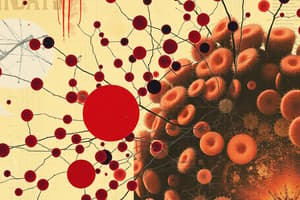Podcast
Questions and Answers
What is the first committed erythroid progenitor called?
What is the first committed erythroid progenitor called?
- Basophilic Erythroblast
- Normoblast
- Proerythroblast (correct)
- Polychromatic Erythroblast
Which feature distinguishes proerythroblasts from granulopoietic cells?
Which feature distinguishes proerythroblasts from granulopoietic cells?
- Condensed nuclei
- Cytoplasm with high granularity
- Low hemoglobin levels (correct)
- Presence of visible granules
What is the significance of ribosomes in basophilic erythroblasts?
What is the significance of ribosomes in basophilic erythroblasts?
- They contribute to the color of the RBCs
- They form the nucleus of the cell
- They indicate a later stage of erythropoiesis
- They are involved in hemoglobin synthesis (correct)
What is a key characteristic of polychromatic erythroblasts?
What is a key characteristic of polychromatic erythroblasts?
During which stage does the nucleus begin to condense?
During which stage does the nucleus begin to condense?
How can erythropoietic cells be distinguished from granulopoietic cells?
How can erythropoietic cells be distinguished from granulopoietic cells?
What process begins during the proerythroblast stage?
What process begins during the proerythroblast stage?
Which of the following describes a significant characteristic of erythropoietic cells throughout their development?
Which of the following describes a significant characteristic of erythropoietic cells throughout their development?
What characterizes a polychromatic erythroblast?
What characterizes a polychromatic erythroblast?
At what stage is the nucleus at its smallest size before being extruded?
At what stage is the nucleus at its smallest size before being extruded?
What happens to the cytoplasm as erythroblasts mature?
What happens to the cytoplasm as erythroblasts mature?
Which feature is a hallmark of the orthochromatic erythroblast?
Which feature is a hallmark of the orthochromatic erythroblast?
What is the primary reason for the shift from basophilic to eosinophilic staining in erythroblasts?
What is the primary reason for the shift from basophilic to eosinophilic staining in erythroblasts?
During what stage does hemoglobin synthesis significantly intensify?
During what stage does hemoglobin synthesis significantly intensify?
Which of the following best describes the changes in the nucleus of erythroblasts as they mature?
Which of the following best describes the changes in the nucleus of erythroblasts as they mature?
Which staining characteristics would you expect in a young erythroblast?
Which staining characteristics would you expect in a young erythroblast?
What is the primary distinguishing feature of a myelocyte?
What is the primary distinguishing feature of a myelocyte?
Which of the following best describes a metamyelocyte?
Which of the following best describes a metamyelocyte?
What is the role of granulocyte-colony stimulating factor (G-CSF)?
What is the role of granulocyte-colony stimulating factor (G-CSF)?
At which stage does the nucleus become fully indented, resembling that of a band neutrophil?
At which stage does the nucleus become fully indented, resembling that of a band neutrophil?
What morphological change occurs in the band neutrophil stage?
What morphological change occurs in the band neutrophil stage?
Which stages of granulocyte development involve mitotic divisions?
Which stages of granulocyte development involve mitotic divisions?
Which granulocyte is characterized by having a multilobed nucleus?
Which granulocyte is characterized by having a multilobed nucleus?
Which of the following types of granules are predominant in myelocytes?
Which of the following types of granules are predominant in myelocytes?
What happens to the cytoplasm as one progresses from promyelocyte to metamyelocyte?
What happens to the cytoplasm as one progresses from promyelocyte to metamyelocyte?
Which cytokine is NOT involved in the regulation of granulopoiesis?
Which cytokine is NOT involved in the regulation of granulopoiesis?
Flashcards are hidden until you start studying
Study Notes
Granulopoiesis
- Granulocytes are white blood cells that contain granules in their cytoplasm
- Granulopoiesis is the process of granulocyte formation
Myeloblast
- First committed granulocyte progenitor
- Does not have any granules
- Large and has a round nucleus
Promyelocyte
- Contains primary granules (azurophilic granules)
- These granules contain lysosomal enzymes and other proteins involved in phagocytosis
- Undergoes mitotic divisions to replenish itself and other granulocyte precursors
Myelocyte
- Contains secondary granules (specific granules)
- Secondary granules determine the granulocyte subtype (neutrophil, eosinophil, or basophil)
- The nucleus undergoes morphological changes and becomes indented
Metamyelocyte
- Nucleus becomes more indented, resembling a horseshoe shape
- Cytoplasm becomes more abundant and replete with secondary granules, becoming predominant
Band Neutrophil
- Nucleus becomes fully horseshoe-shaped
- Cytoplasm contains numerous secondary granules
- Ready to enter the bloodstream
Mature Segmented Neutrophil
- Fully developed neutrophil with a multilobed nucleus
- Contains abundant granules for phagocytosis
- Circulates in the bloodstream for a few days before entering tissues to fight infections
Erythropoietic Cells
- Do not have granules
- Have a round nucleus
- Can be distinguished based on their size, condensation of the nucleus, and cytoplasm color
Proerythroblast
- Also known as pronormoblast
- First committed erythroid progenitor
- Large, nucleated cell with abundant cytoplasm
- Undergoes mitotic divisions to produce more erythroid progenitors
- Contains basophilic cytoplasm
- Begins hemoglobin synthesis
Basophilic Erythroblast
- Also known as basophilic normoblast
- Intensely basophilic because of ribosomes
- Synthesizes hemoglobin
- Nucleus starts to condense
- Continues to undergo mitotic divisions to replenish RBC precursor cells
Polychromatic Erythroblast
- When the level of RNA and hemoglobin are almost equal
- Mixed red and blue staining showing both hemoglobin and ribosomes
- Nucleus becomes smaller
- Begins to expel organelles
- Hemoglobin synthesis has intensified
Orthochromatic Erythroblast
- Contains a condensed pyknotic nucleus at its smallest size
- Primarily stains red because of abundant hemoglobin
- Last stage with a nucleus
- Continues to expel organelles
- Intensified hemoglobin synthesis
Stages of Erythroblast Development
- Cells are larger when they are younger
- Cytoplasm becomes relatively smaller as they become more mature
- Cells are predominantly basophilic because of the abundance of RNA when they are young
- Basophilic character disappears and is replaced by eosinophilic character attributed to the abundance of hemoglobin as cells produce more hemoglobin.
Studying That Suits You
Use AI to generate personalized quizzes and flashcards to suit your learning preferences.




